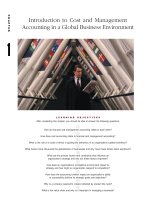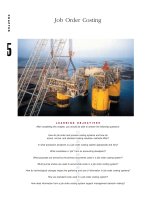Cost accounting chapter 03
Bạn đang xem bản rút gọn của tài liệu. Xem và tải ngay bản đầy đủ của tài liệu tại đây (572.95 KB, 19 trang )
Cost-Volume-Profit Analysis
© 2009 Pearson Prentice Hall. All rights reserved.
A Five-Step Decision Making Process in
Planning & Control Revisited
1. Identify the problem and uncertainties
2. Obtain information
3. Make predictions about the future
4. Make decisions by choosing between
alternatives, using Cost-Volume-Profit (CVP)
analysis
5. Implement the decision, evaluate performance,
and learn
© 2009 Pearson Prentice Hall. All rights reserved.
Foundational Assumptions in CVP
Changes in production/sales volume are the sole
cause for cost and revenue changes
Total costs consist of fixed costs and variable
costs
Revenue and costs behave and can be graphed as
a linear function (a straight line)
Selling price, variable cost per unit and fixed costs
are all known and constant
In many cases only a single product will be
analyzed. If multiple products are studied, their
relative sales proportions are known and constant
The time value of money (interest) is ignored
© 2009 Pearson Prentice Hall. All rights reserved.
Basic Formulae
© 2009 Pearson Prentice Hall. All rights reserved.
CVP: Contribution Margin
Manipulation of the basic equations yields an
extremely important and powerful tool
extensively used in Cost Accounting: the
Contribution Margin
Contribution Margin equals sales less variable
costs
CM = S – VC
Contribution Margin per Unit equals unit
selling price less variable cost per unit
CMu = SP – VCu
© 2009 Pearson Prentice Hall. All rights reserved.
Contribution Margin, continued
Contribution Margin also equals contribution
margin per unit multiplied by the number of
units sold (Q)
CM = CMu x Q
Contribution Margin Ratio (percentage) equals
contribution margin per unit divided by Selling
Price
CMR = CMu ÷ SP
Interpretation: how many cents out of every sales
dollar are represented by Contribution Margin
© 2009 Pearson Prentice Hall. All rights reserved.
Basic Formula Derivations
The Basic Formula may be further rearranged
and decomposed as follows:
Sales – VC – FC = Operating Income
(OI)
(SP x Q) – (VCu x Q) – FC = OI
Q (SP – VCu) – FC = OI
Q (CMu) – FC = OI
Remember this last equation, it will be used
again in a moment
© 2009 Pearson Prentice Hall. All rights reserved.
Breakeven Point
Recall the last equation in an earlier slide:
Q (CMu) – FC = OI
A simple manipulation of this formula, and setting
OI to zero will result in the Breakeven Point
(quantity):
BEQ = FC ÷ CMu
At this point, a firm has no profit or loss at the
given sales level
If per-unit values are not available, the Breakeven
Point may be restated in its alternate format:
BE Sales = FC ÷ CMR
© 2009 Pearson Prentice Hall. All rights reserved.
Breakeven Point, extended:
Profit Planning
With a simple adjustment, the Breakeven
Point formula can be modified to become a
Profit Planning tool.
Profit is now reinstated to the BE formula,
changing it to a simple sales volume equation
Q = (FC + OI)
CM
© 2009 Pearson Prentice Hall. All rights reserved.
CVP: Graphically
© 2009 Pearson Prentice Hall. All rights reserved.
Profit Planning, Illustrated
© 2009 Pearson Prentice Hall. All rights reserved.
CVP and Income Taxes
From time to time it is necessary to move back
and forth between pre-tax profit (OI) and aftertax profit (NI), depending on the facts presented
After-tax profit can be calculated by:
OI x (1-Tax Rate) = NI
NI can substitute into the profit planning
equation through this form:
OI = I I
NI
I
(1-Tax Rate)
© 2009 Pearson Prentice Hall. All rights reserved.
Sensitivity Analysis
CVP Provides structure to answer a variety of
“what-if” scenarios
“What” happens to profit “if”:
Selling price changes
Volume changes
Cost structure changes
Variable cost per unit changes
Fixed cost changes
© 2009 Pearson Prentice Hall. All rights reserved.
Margin of Safety
One indicator of risk, the Margin of Safety
(MOS) measures the distance between
budgeted sales and breakeven sales:
MOS = Budgeted Sales – BE Sales
The MOS Ratio removes the firm’s size from
the output, and expresses itself in the form of
a percentage:
MOS Ratio = MOS ÷ Budgeted Sales
© 2009 Pearson Prentice Hall. All rights reserved.
Operating Leverage
Operating Leverage (OL) is the effect that
fixed costs have on changes in operating
income as changes occur in units sold,
expressed as changes in contribution margin
OL = Contribution Margin
Operating Income
Notice these two items are identical, except
for fixed costs
© 2009 Pearson Prentice Hall. All rights reserved.
Effects of Sales-Mix on CVP
The formulae presented to this point have
assumed a single product is produced and
sold
A more realistic scenario involves multiple
products sold, in different volumes, with
different costs
The same formulae are used, but instead
use average contribution margins for
bundles of products.
© 2009 Pearson Prentice Hall. All rights reserved.
Multiple Cost Drivers
Variable costs may arise from multiple cost
drivers or activities. A separate variable cost
needs to be calculated for each driver.
Examples include:
Customer or patient count
Passenger miles
Patient days
Student credit-hours
© 2009 Pearson Prentice Hall. All rights reserved.
Alternative Income Statement Formats
© 2009 Pearson Prentice Hall. All rights reserved.
© 2009 Pearson Prentice Hall. All rights reserved.









